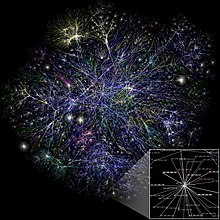internet

Visualization of the Internet from Opte project data (15 January 2005)
The Internet (from the English interconnected networks - connected networks; colloquially: net, network) is a publicly available worldwide system of interconnected computer networks that transmit data using packet data switching using the standardized Internet Protocol (IP) and many other protocols. It consists of thousands of smaller commercial, non-commercial, academic, private, government and military computer networks. It serves as a transmission medium for various information and services such as e-mail, chat and especially the system of interconnected hypertext documents (web pages) and web applications called the World Wide Web (WWW). The Internet does not have a single, centralized management of technology implementation or access and use policies. Each network that is part of it sets its own policies. The common definitions of the two main pillars of the Internet: the Internet Protocol Address Space (IP address) and the Domain Name System (DNS) are managed by the Internet Corporation for Assigned Names and Numbers (ICANN). Technical support and standardization of basic protocols is the activity of the Internet Engineering Task Force (IETF).
Today's Internet
In addition to the complex physical connections that make up the structure of the Internet, the Internet also exists thanks to multilateral agreements (e.g. "peering agreements" and technical specifications or protocols that determine how data is to be exchanged over the network).
Unlike legacy communication systems, the Internet Protocol Suite was deliberately designed to be agnostic with respect to the physical medium on which it runs. Any communications network, fixed or wireless, that is capable of transmitting two-way digital data can carry Internet traffic. Therefore, Internet packets can be transmitted over fixed networks such as copper wire, coaxial cable and optical cable, as well as wireless networks such as Wi-Fi. All these networks sharing the same set of higher-level protocols make up the Internet.
Internet protocols originate from discussions within the Internet Engineering Task Force (IETF) and its working groups, which are open to public input and revision. These committees produce documents known as Request for comments (RFC). Some RFCs are promoted by the Internet Architecture Board (IAB) to Internet standards.
The most commonly used Internet protocols in the Internet Protocol Suite include IP, TCP, UDP, DNS, PPP, SLIP, ICMP, POP3, IMAP, SMTP, HTTP, HTTPS, SSH, Telnet, FTP, LDAP, SSL, and TLS.
Services that use these protocols are e-mail, Usenet newsgroups, World Wide Web, Gopher, session access, WAIS, finger, IRC, MUDy and MUSHe. The most used of these are e-mail and the World Wide Web, with many other services based on them, such as mailing lists, blogs and podcasts. The Internet enables the provision of real-time services such as telephone calls, Internet radio and Internet (television) broadcasting, which are thus accessible anywhere in the world.
Some other popular Internet services did not originate in this way, but were originally based on proprietary systems. These include IRC, ICQ, AIM and Gnutella.
There have been many analyzes of the Internet and its structure. For example, the IP routing structure of the Internet and the hypertext links of the World Wide Web have been found to be examples of scale-free networks.
Similar to how internet providers connect via internet exchange points (e.g. SIX – Slovak Internet eXchange), research networks tend to connect to large subnets such as:
GIANT,
Internet2,
Little GLORIAD.
These, in turn, are built around relatively small networks.
Current and potential problems
In addition to the advantages, the Internet has also brought some problems and negatives. Some of them received a lot of publicity.
They mainly include:
child abuse related to child pornography
copyright infringement
spread of computer viruses
computer security attacks
outdated technology
Censorship
In democratic societies, the Internet has gained new significance as a political tool. Howard Dean's 2004 presidential campaign in the United States became known for its ability to secure sponsorships over the Internet.
Some governments, such as those in Cuba, Iran, the DPRK, Myanmar, China, or Saudi Arabia, restrict what people in their countries can access on the Internet. These are mainly restrictions on access to political and religious content. They achieve this by filtering domains and content so that it is not easily accessible without elaborate procedures.
In Norway, Denmark, Finland[1] and Sweden, the major Internet providers have agreed to restrict sites designated by the police. Despite the fact that the list of banned URLs should contain only the addresses of known sites with child pornography, the content of the list is kept secret.
A number of countries, incl
